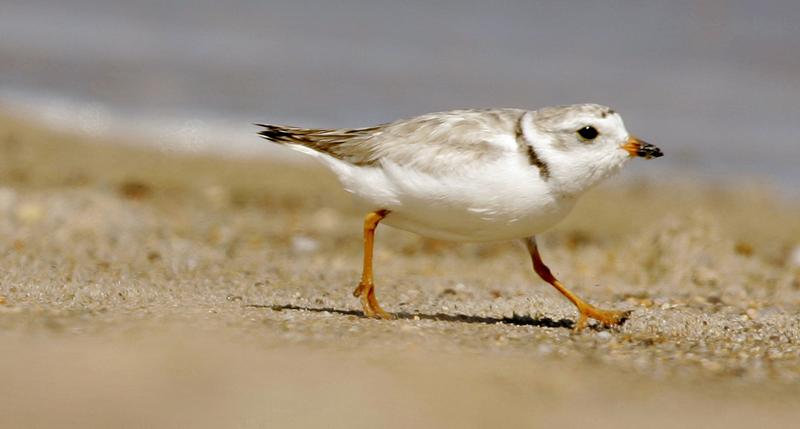Protecting Piping Plovers

( Steven Senne/FILE / AP Photo )
[music]
Brian Lehrer: Brian Lehrer on WNYC. They'll have some spring vibes with naturalist Gabriel Willow coming up on all of it. Let's get the spring vibes going a little early right here because with spring in the air and summer approaching, we humans will flock to the beaches, along with actual flocks of birds, including the piping plover. If you spend time on the beaches in our area, you've probably seen areas of the beach roped off and seen signs about the piping plovers nests and maybe wondered why this shorebird gets so much prime sandy beachfront space.
If you visited the western end of the Rockaway peninsula in Queens last summer for Tilden Jacob Riis Park, maybe you met some of the nice people in blue t-shirts there to explain it all to you. They're part of the volunteer New York City Plover Project, and their founder, Chris Allieri joins me now. Chris, welcome to WNYC.
Chris Allieri: Thanks, Brian. Thanks a lot for having me. I want to thank you and the show for always talking about birds and wildlife in New York City. It's so important.
Brian: Thank you. Let's start with just a little lesson on the piping plover, how do you recognize it and why does it need some of the beach to itself?
Chris: That's a great question. You first recognize the piping plover from its signature flute-like call. You'll hear it off in the distance, sometimes closer, sometimes near. It basically needs those protections because the numbers are really dire. The global population is somewhere between 6,000 and 8,000 total birds. In New York City in 2020 and 2021, along the Rockaway peninsula, there were just 100 piping plovers. I think sometimes people are surprised when they hear that there are so few and they nest right there on the sand.
Brian: Is it technically an endangered species?
Chris: Yes. The Endangered Species Act does grant protections to piping plovers as well as the Migratory Bird Treaty Act. In the state of New York, they are an endangered species. Federally, they're listed as a threatened species. In the big scheme of things, in terms of our responses as societies and agencies, threatened species are also very much in danger as well.
Brian: Yes. Listeners, we can't give you a picture on the radio, but you've definitely seen these birds. If you go to the beach, these fairly small white birds with little feet that are so skinny. It's amazing they can stand up.
Chris: The chicks are even smaller and they're impossibly cute.
Brian: I don't think I've ever seen a chick.
Chris: Yes, and they're impossibly small. I invite you out to the Rockaways. We're really lucky in New York City, in the Jamaica Bay estuary and ecosystems. It's some of the most special natural places in the world, and people come from all over. I think that a lot of times the discussion around piping plovers focuses on the signs or it focuses on the closed beaches. In New York City, there's only one mile of beach that is closed to protect the chicks and that's on the eastern end of the peninsula.
If we look at the other way in terms of how cool is it that we have this endangered species that continually nests in New York City and is thriving, the numbers are stable, but we need to get that nesting success up, and that's where our volunteer corps has come in.
Brian: What is it that people or maybe our dogs do that endangers the piping plovers? Is it just inadvertently stepping on their nests?
Chris: Yes, that's a great question. The dog issue is a dicey one. A lot of our volunteers have dogs, we love dogs and there's a lot of dog owners out on the Rockaways. I think that what it is, it's about New York City Audubon, and New York City Parks and a lot of different agencies and organizations have advanced share the shore messaging and it really is about sharing those beaches.
On the eastern end of the peninsula, east of Beach 149th Street, you've got throughout most of the Rockaways, people can bring dogs on the beach with a leash until Memorial Day weekend. Then from Memorial Day to August, September, that's when there are no dogs on the beach. On the western end, there are no dogs now from March through September.
When folks are out at the beach, I think that they may inadvertently walk into their nesting areas.
Our volunteers were out with Park Rangers and staff, the Natural Resources staff, and biotechs of the National Park Service Gateway National Recreation area last weekend, or two weekends ago, and we were installing miles of symbolic fencing, which is basically posts and string line. It's symbolic as it's not an actual barrier, but it does keep us humans at least a lot of them or most of them away.
I think that what we've realized is that people don't respond to signs as effectively as they do a conversation with a human, and they especially don't respond to somebody yelling at them. That's the antithesis of what we do. We're out there, we're really engaging with folks. thank you for mentioning our t-shirts. An amazing designer, my friend Scott Mayola of Simplicissimus in Queens, actually developed our logo and our t-shirts, and they're distinguished and distinguishable. People see them, and we give out stickers and tattoos. This year, first to announce we're going to be giving out some magnets as well for cars.
Brian: Oh, that's very cute.
Chris: We're pretty excited.
Brian: I remember a certain governor who went down to the Jersey Shore one day and yelled, "Got the hell off the beach." So that doesn't work.
Chris: Listen, I've definitely gotten really annoyed and I think that for me, the inspiration for starting this project last March, it was March 21st last year and there were a ton of dogs off-leash, there were people up on the dunes, and the birds were starting to arrive. We've had a strange spring as you know here in New York City. It's been warm, it's been cold, it's been warm again, it's now seasonal, but the birds have been here.
There are probably a couple of dozen throughout the Rockaways right now. We've counted probably 7 or 10 of them on the western end and I know that our colleagues at NYC parks I've seen several on the east end as well.
Brian: Listeners, if anybody has a piping plover question, we can take a few phone calls in our remaining few minutes, 212-433-WNYC, or for that matter of piping plover story, or for that matter of piping plover call, 212-433-WNYC. It would not be the first time we invited the bird calls on the show. 212--
Chris: I know, I was listening an interview you had with Kaitlyn Parkins of Audubon, and someone called in with the owl call. It was pretty amazing.
Brian: That was too much fun. My guest is Chris Allieri, founder of The New York City Plover Project. 212-433-WNYC, 212-433-9692. The New York City Plover Project supports I see the federal park rangers, who managed the Fort Tilden and Jacob Riis Park beaches, the signs and taped-off areas. On and off, you need park rangers too?
Chris: Yes. Gateway is a really amazing National Park. It's part of the National Park system. It's in two states. It's in New Jersey at Sandy Hook, and it's throughout the Jamaica Bay Estuary, Floyd Bennett Field, which is a really cool historic place, and of course, the Jamaica Bay Wildlife Refuge where over 330 bird species have been seen consistently. That park, they have a great staff and a great team, but it's a large area and it's very complicated urban parks.
They needed the help, and this was an opportunity. In 2020, like many New Yorkers, I found new hobbies at the beginning days of the pandemic and I first picked up a binoculars and a camera and I a year later, was starting this initiative and we quickly recruited over 50 volunteers. We have 1200 hours on the beach and reached almost 10,000 people our first year. We're hoping to double that and magnify that in a big way this year as well. We have a big training coming up on the 23rd of April.
Brian: Tiffany in Brooklyn, you're on WNYC. Hi, Tiffany.
Tiffany: Hi, Brian. Long-time listener. I was actually just out at Fort Tilden last weekend with my two dogs. Actually, a volunteer came up to us and it was the first time we had ever really-- We had no information on the birds, we've really learned a lot, but one of the things she had said was that even if you do have your dog on the leash and not up in the dunes where they are, they go down to eat and we interrupt their eating patterns by having the dogs or even just us being there.
Anyway, and also in addition to that, we did leave with the dogs right away and I'm really grateful for the experience and learning all this information, but then on our way out we were stopped by officers and they were yelling and to your point, that was less effective for us than actually learning about the birds.
Brian: Tiffany, thank you for the first-person report. Thanks for calling call, call again. Here's Sherry in Westchester who says she's a piping plover steward on long island. Do I have that right, Sherry? Hi.
Sherry: Yes. Hi Brian, I was happy to be a piping plover steward for the town of Babylon for about five or six years during college.
Brian: What does a piping plover steward do?
Sherry: The piping clover steward, we would go out in the beginning of the nesting season and basically identify where the plovers were starting to nest and we would be responsible for putting up the protective fencing and stuff like that to keep people away from the nest sites.
Brian: Were people receptive? I mean, Chris has been talking about some of the experience of better and worse ways to interact and more effective and less effective ways to interact. What was that like for you?
Sherry: We did have to educate people every once in a while if we saw folks going up on the dunes. One thing I wanted to add to the conversation is when you're a steward, you learn that the amount of-- Really the time that you are even near the nest site can really disturb the bird's behavior and could potentially cause the parent birds to abandon the nest. It's not only that we are potentially stepping on them or accidentally killing the chicks or anything, it's really even the disturbance itself.
Even down to the Jones Beach air show every year, with the fighter jets that used to go over at the Jones Beach air show, we would have to monitor the bird behavior to ensure that they weren't abandoning due to all of that disturbance. They're very sensitive.
Brian: Wow. Sherry, thank you very much, Chris. The air show, that can freak out the plovers?
Chris: Yes. I would say so kites, even on a much smaller scale--
Brian: Kites?
Chris: Yes, exactly because they're seen they're an aerial predator. They could be a peregrine falcon or another sort of raptor, but to Sherry's point, she's absolutely correct, once those nest are active our volunteers, aren't going near the nests at all. They're behind those string lines and what is most important, and this is the critical period both the parents of the piping clovers incubate those nests and it takes about 20, 21 days for those nests to hatch.
Then another three weeks after that for those birds to fledge or to be able to fly. After an hour or so those birds need to-- They're running all over the beach. There's no safe nest, like some tree nesting birds. They're all over the beach and if they don't have access to the waterline they will not make it. That's why we have so high fatality rate of the chicks. I don't want to end on a sad note, but we do have a steep hill climb.
With that, we're definitely open for more volunteers. Like I said, we do have a training on the 23rd, a Saturday. We have burritos from Super Burrito and Rockaway and local coffee too. You can go ahead to our, on our website and just real quick on Tiffany's point on the dogs. I'm so sorry she had that experience with the park service staff. I'll definitely talk with them about that.
That shouldn't have happened, but I was heartened by hearing what she had to say about the presence of the dogs and yes, it's absolutely most imperative when that nesting activity happens and we're going to see nests really start going on within the next few weeks.
Brian: We have time remaining for about a sound bite lane phone call from Andrew in far Rockaway, Andrew you're on WNYC. 20 seconds for you.
Andrew: Thank you so much. I just want to say that New York is blessed with miles of beaches and we're so lucky as a city, almost more beaches than we could use and sharing a few more miles with the plovers, I think is a great and easy thing to do.
Brian: Andrew, thank you very much.
Chris: That pretty amazing. Thank you, Andrew. Absolutely the truth you. Thank you.
Brian: You want to end Chris just by telling people how to get in touch with the New York city polar project, if they want to volunteer? We have 10 seconds.
Chris: Sure. nycploverproject.org. You can follow us on Twitter and Instagram and of course, Facebook and go and sign up for our training. We need loads of volunteers. You'll get a great blue t-shirt and you'll be a part of a really fun volunteer initiative this spring and summer. Thank you, Brian.
Brian: Chris Allieri, founder of the New York City Plover Project and thanks to the American Bird Conservancy in the creative commons. We're going to give the last word in this segment to some piping plovers.
Copyright © 2022 New York Public Radio. All rights reserved. Visit our website terms of use at www.wnyc.org for further information.
New York Public Radio transcripts are created on a rush deadline, often by contractors. This text may not be in its final form and may be updated or revised in the future. Accuracy and availability may vary. The authoritative record of New York Public Radio’s programming is the audio record.

